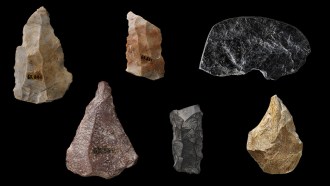
Bruce Bower has written about the behavioral sciences since 1984. He often writes about psychology, anthropology, archaeology and mental health issues. Bruce has a master's degree in psychology from Pepperdine University and a master's degree in journalism from the University of Missouri. Following an internship at Science News in 1981, he worked as a reporter at Psychiatric News, a publication of the American Psychiatric Association, until joining Science News as a staff writer. In 1996, the American Psychological Association appointed Bruce a Science Writer Fellow, with a grant to visit psychological scientists of his own choosing. Early stints as an aide in a day school for children and teenagers with severe psychological problems and as a counselor in a drug diversion center provided Bruce with a surprisingly good background for a career in science journalism.

Trustworthy journalism comes at a price.
Scientists and journalists share a core belief in questioning, observing and verifying to reach the truth. Science News reports on crucial research and discovery across science disciplines. We need your financial support to make it happen – every contribution makes a difference.
All Stories by Bruce Bower
-
 Archaeology
ArchaeologyOne of the world’s earliest farming villages housed surprisingly few people
Hundreds, not thousands, occupied the Turkish site of Çatalhöyük nearly 9,000 years ago, undermining arguments for a Neolithic social revolution.
-
 Archaeology
ArchaeologyA puzzling mix of artifacts raises questions about Homo sapiens' travels to China
A reexamined Chinese site points to a cultural mix of Homo sapiens with Neandertals or Denisovans.
-

How Ötzi the Iceman really got his tattoos
Modern tattooing experiments challenge a popular idea about how the roughly 5,200-year-old mummified man got marked with dark lines.
-
 Archaeology
ArchaeologyThese South American cave paintings reveal a surprisingly old tradition
Radiocarbon dates point to an artistic design practice that began in Patagonia almost 8,200 years ago, several millennia earlier than previously recorded.
-
 Archaeology
ArchaeologyA four-holed piece of ivory provides a glimpse into ancient rope-making
The tool, unearthed in Central Europe, suggests that locals made devices for stringing together sturdy cords over 35,000 years ago, researchers say.
-
 Climate
ClimateCold, dry snaps accompanied three plagues that struck the Roman Empire
New climate data for ancient Italy point to temperature and rainfall influences on past infectious disease outbreaks.
-
 Genetics
GeneticsHow ancient herders rewrote northern Europeans’ genetic story
New DNA analyses show the extent of the Yamnaya people’s genetic reach starting 5,000 years ago and how it made descendants prone to diseases like MS.
-
 Anthropology
AnthropologySpanish horses joined Indigenous South Americans’ societies long before Europeans came to stay
By the early 1600s, hunter-gatherers at the continent’s southern tip adopted horses left behind by colonial newcomers, new finds suggest.
-
 Archaeology
ArchaeologyAncient Maya power brokers lived in neighborhoods, not just palaces
Lidar discoveries and recent excavations are forcing archaeologists to rethink ancient Maya political structures.
-
 Archaeology
ArchaeologyA mysterious ancient grave with a sword and mirror belonged to a woman
The items hint that she fought in or helped plan raids and defensive actions in what’s now southwestern England about 2,000 years ago, scientists speculate.
-
 Anthropology
AnthropologySurprisingly long-lived wild female chimps go through menopause
Chimpanzees in Uganda are the first known example of wild, nonhuman primates experiencing the hormonal changes, raising questions about how menopause evolved.
-
 Archaeology
ArchaeologyNeandertals hunted cave lions at least 48,000 years ago
A new study reports the first direct evidence of Neandertals slaying the big cats, and the earliest evidence of any hominids killing a large predator.